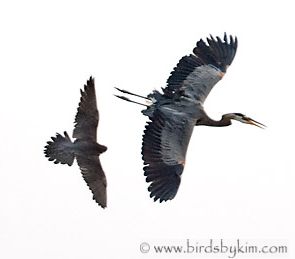 Last weekend in Wilmington, Delaware, Kim Steininger watched an amazing thing near the local peregrine falcons’ nest. The mother peregrine saw a great-blue heron fly through the area … and attacked it!
Last weekend in Wilmington, Delaware, Kim Steininger watched an amazing thing near the local peregrine falcons’ nest. The mother peregrine saw a great-blue heron fly through the area … and attacked it!
I’ve never seen anything like this before. Herons are fish-eating wading birds who have no interest in eating peregrine babies. I can only imagine that the heron’s wingspan reminded the falcon of a bird of prey.
Kim’s amazing pictures are on her blog – or click on the photo to go there directly.
One thing is certain. This heron will not fly through the peregrines’ zone for a long time to come.
Thanks to Kim Steininger for permission to use her photo. Totally awesome!
What awesome pictures! Thanks so much for having this in your blog. I can totally understand why you have been following the peregrines. I guess “someone” bumped the camera on the cathedral,unfortunately. I am sad that I will not be able to watch E2 take his afternoon siesta. Yesterday I happened to click on the site in Columbus in time to see Orville feed his chicks. It was right in front of the camera! Those talons are very scary. Lately one of the chicks has be cuddling up to the camera so that there have been many feather shots. I assume that all is well with Dorothy, E2 and the gang. Thanks again for your insights.
All is well with the Pitt peregrine family. The juveniles are all flying well & are starting to perch on other buildings. This morning there was a peregrine on St. Paul’s Cathedral spire.
Since there are no youngun’s in the nest, the Pitt camera has been set to close focus in hopes we’ll be able to read E2’s bands – if he ever comes back to the nest.
A little while ago he was there. It is been my experience that he usually at the nest from after 12 until 1pm or later. When the sun hits the front of the nest box. Then he goes into the shade in the nest box. Here’s hoping that the bands can be read. Do you think that he is one of Dorothy’s sons, since he seems to come back there so often…or is that being too anthropomorphic?
Actually, this morning it’s been Dorothy herself.
Perhaps it has been Dorothy that I have been seeing in the afternoons, since I am not too good with the size thing. Did I read on your blog or somewhere else that males have a brighter yellow beak? If so, I think I have also seen E2 back at the nest in the past.
E2 has probably been there too. We think E2 is younger than Dorothy. A yellower beak tends to be a trait of younger peregrines. Who knows…
Heron: “Right, never taking THAT shortcut again!”
Those are some truly amazing photos.
Thank you for linking us to Kim’s pictures. They were amazing. In the final shot, Mom’s eyes seem completely fixed on Kim’s camera. What a facial expression! Kate, I’ve been enjoying your blog and the falcon cams all spring. Thank you for your insights. –Patty